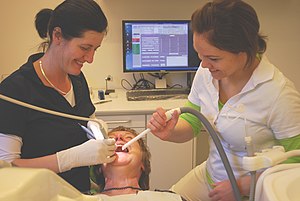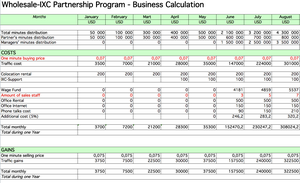With all the technologic advances and sophistication coming to the fore in the dental armamentarium, the advancement and sophistication necessary to ensure their delivery to a consumer base faced with a schizophrenic economy is lacking.
Starting a new practice–JUMP START strategies
Success doesn’t happen by accident. Building a new dental practice,
which is really starting a new business, is one of the biggest professional
steps a dentist will ever take in his or her career. Unfortunately, many
dentists open a new practice without clearly understanding the multiple roles
they must fill for that business to grow and thrive. So they miss critical
steps that set the foundation for long-term success. The hard work happens before you even open your doors to patients. But,with the right
resources and the right team of experts,you can create your plan for success.
–Lisa Philp
Creating
your practice start-up squad
Dentists today have so
many resources available to them to help shorten the learning curve and
minimize mistakes. Don’t be afraid or reluctant to tap into these valuable
resources. Create a Practice Start-up Squad, which would consist of those
individuals or businesses with the experience, insight and expertise to help
you make the right decisions. Your team might include a transitions coach to
help you manage change, your lender, your finance company and your equipment
specialist. Also consider enlisting the advice of a local practitioner as a
mentor. Then,ask as many questions of your Start-up Squad as you can, going
beyond their specific area of “expertise.” For example, your equipment
specialist may have the inside track to a great location or an alliance with a
real estate agent.
Develop a
business plan lenders will fund
After you’ve gathered your
team of experts, it’s time to use their insight to help develop a strategic
business plan.
Although there is no set
formula, there’s a simple way to create a business plan that involves answering
of the following questions.
· How many
treatment rooms will you have?
· What will be your hours of operation?
· How will
you retain patients and overcome cancellations and no shows from the beginning?
· number of
new patients
· what you
will produce in dollars per hour
· Collection
strategies
· Overhead
analysis and cash flow projections
· type of
demographic you will be serving,
· the
technology with which you will need to be current
· periodontal
program you implement before and after you hire a hygienist.
· What team roles will you need?
· Where
will you look for good candidates?
· What
types of personalities will be a good fit to reduce stress and help build the
practice?
Think through each of these areas as you create
your business plan, financial analysis, and a three-year cash projection and a
budget for the initial construction. Your business plan helps the lender
understand your goals and vision, and demonstrates that you’ve done your due
diligence and research. This includes looking at locations, demographics,
equipment costs, and market potential. The better the business plan, the more
you can get through financing
.
Leadership
is a learned skill
The dentist is the leader
of the practice; the one who sets the vision, the culture, the pace, and the
tone for the whole team. Every dental practice is a “two-way mirror” reflection
of the dentist. Even if the dentist has brilliant technical skills, he or she
may have had minimal guidance on how to lead and manage a business. The good
news is that leadership, just like any dental procedure, can be learned!

Image via Wikipedia
It starts
with understanding the type of leader you are (and want to be), and your
strengths and weaknesses. Then, it’s finding and utilizing the resources
readily available in dentistry. There’s a plethora of continuing education
opportunities. Dentists can attend courses on leadership development, either
inside or outside of dentistry, they can engage a leadership coach to work with
them one on one, or they can bring
in a leadership and team developer coach to work side by side with them and
their team.
Setting
and writing goals
Another leadership
responsibility is to develop a set of goals for the practice. This is probably
the most commonly overlooked step, but it is the foundation of establishing a
predictable, successful practice. This is because all decisions should be made
based on the goals the dentist has for his or her practice, including location,
fee structure, staff, and marketing. So, sit down and take some time to
self-reflect. Ask yourself the hard questions. Where would you like to live?
What type of patients do you want to serve? How much do you need to earn and
how much would you like to earn? Be specific. These are only a few of the
questions you need to consider.I strongly encourage you to take your time at
this critical step, because your initial decisions will affect the next 30 to
40 years of your career. And please, be part of the 3 percent of the population
who write down their goals – goals that are specific, measurable, attainable,
relevant, and trackable. Then, as you begin making those critical
decisions,make sure they fit the goals you’ve set and written down. For
example, if you want to be a fee-for-service practice,perform your due
diligence and make sure you plant your practice in a community with a patient
base that makes that goal attainable.
Building
a high-performing team
A dentist can’t survive
without a high-performing dental team. There is significant historical
information that indicates85 percent of the success of a dental practice is
based on the team’s ability to meet the “human needs” of their patients. The

Image via Wikipedia
remaining 15 percent is based on the dentist’s technical ability. Developing
your high-performing team is much easier when everyone buys into your vision
and goals and knows their roles with clear, written job descriptions. Most new
practices employ at least one administrative team member to manage the business
office and one dental assistant to work chairside. Don’t reinvent the wheel
when it comes to developing compensation plans and personnel policies. Use
industry benchmarks and the wide variety of resources available online such as
Bent Erickson.com. They are experts in labor laws and personnel policies for
every state. When recruiting and interviewing your potential employees,
consider three major areas of characteristics:?? Do they
have experience in their role-specific duties?
Creating
efficient and effective revenue drivers
Let’s take a look at
probably the most important revenue driver: the number of active patients.
Without patients, it doesn’t matter what facility you have and how good you are
clinically, because there is no dentistry to do. To drive in new patients you
will need to spend 50 to 60 percent of your energy and at least 5 to 7 percent
of your collections in your first three years on internal and external
marketing. Another critical lever is the practice’s financial policy. To do it
right, right from the start, concentrate on dentistry and stay out of the
banking business – which means no accounts receivable. Especially for new
practices, cash flow is critical to success and your ability to meet payroll.
So, find an outside patient financing partner, such as CareCredit, who can be
an advocate in helping you optimize your resources without putting you at risk
for non-paying patients. Another important revenue driver is the new patient
flow. You will need a minimum of 50 to 60 new patients per month to allow for
optimal growth. UltiStarting a new practice–JUMP START strategies
Success doesn’t happen by accident. Building a new dental practice,
which is really starting a new business, is one of the biggest professional
steps a dentist will ever take in his or her career. Unfortunately, many
dentists open a new practice without clearly understanding the multiple roles
they must fill for that business to grow and thrive. So they miss critical
steps that set the foundation for long-term success. The hard work
happens before you even open your doors to patients. But, with the right
resources and the right team of experts, you can create your plan for success.
–Lisa Philp
Creating
your practice start-up squad
Dentists today have so
many resources available to them to help shorten the learning curve and
minimize mistakes. Don’t be afraid or reluctant to tap into these valuable
resources. Create a Practice Start-up Squad, which would consist of those
individuals or businesses with the experience, insight and expertise to help
you make the right decisions. Your team might include a transitions coach to
help you manage change, your lender, your finance company and your equipment
specialist. Also consider enlisting the advice of a local practitioner as a
mentor. Then,ask as many questions of your Start-up Squad as you can, going
beyond their specific area of “expertise.” For example, your equipment
specialist may have the inside track to a great location or an alliance with a
real estate agent.
Develop a
business plan lenders will fund
After you’ve gathered your
team of experts, it’s time to use their insight to help develop a strategic
business plan.
Although there is no set
formula, there’s a simple way to create a business plan that involves answering
of the following questions.
· How many
treatment rooms will you have?
· What will be your hours of operation?
· How will
you retain patients and overcome cancellations and no shows from the beginning?
· number of
new patients
· what you
will produce in dollars per hour
· Collection
strategies
· Overhead
analysis and cash flow projections
· type of
demographic you will be serving,
· the
technology with which you will need to be current
· periodontal
program you implement before and after you hire a hygienist.
· What team roles will you need?
· Where
will you look for good candidates?
· What
types of personalities will be a good fit to reduce stress and help build the
practice?
Think through each of these areas as you create
your business plan, financial analysis, and a three-year cash projection and a
budget for the initial construction. Your business plan helps the lender
understand your goals and vision, and demonstrates that you’ve done your due
diligence and research. This includes looking at locations, demographics,
equipment costs, and market potential. The better the business plan, the more
you can get through financing
Leadership
is a learned skill
The dentist is the leader
of the practice; the one who sets the vision, the culture, the pace, and the
tone for the whole team. Every dental practice is a “two-way mirror” reflection
of the dentist. Even if the dentist has brilliant technical skills, he or she
may have had minimal guidance on how to lead and manage a business. The good
news is that leadership, just like any dental procedure, can be learned! It starts
with understanding the type of leader you are (and want to be), and your
strengths and weaknesses. Then, it’s finding and utilizing the resources
readily available in dentistry. There’s a plethora of continuing education
opportunities. Dentists can attend courses on leadership development, either
inside or outside of dentistry, they can engage a leadership coach to work with
them one on one, or they can bring
in a leadership and team developer coach to work side by side with them and
their team.
Setting
and writing goals
Another leadership
responsibility is to develop a set of goals for the practice. This is probably
the most commonly overlooked step, but it is the foundation of establishing a
predictable, successful practice. This is because all decisions should be made
based on the goals the dentist has for his or her practice, including location,
fee structure, staff, and marketing. So, sit down and take some time to
self-reflect. Ask yourself the hard questions. Where would you like to live?
What type of patients do you want to serve? How much do you need to earn and
how much would you like to earn? Be specific. These are only a few of the
questions you need to consider.I strongly encourage you to take your time at
this critical step, because your initial decisions will affect the next 30 to
40 years of your career. And please, be part of the 3 percent of the population
who write down their goals – goals that are specific, measurable, attainable,
relevant, and trackable. Then, as you begin making those critical
decisions,make sure they fit the goals you’ve set and written down. For
example, if you want to be a fee-for-service practice,perform your due
diligence and make sure you plant your practice in a community with a patient
base that makes that goal attainable.
Building
a high-performing team
A dentist can’t survive
without a high-performing dental team. There is significant historical
information that indicates85 percent of the success of a dental practice is
based on the team’s ability to meet the “human needs” of their patients. The
remaining 15 percent is based on the dentist’s technical ability. Developing
your high-performing team is much easier when everyone buys into your vision
and goals and knows their roles with clear, written job descriptions. Most new
practices employ at least one administrative team member to manage the business
office and one dental assistant to work chairside. Don’t reinvent the wheel
when it comes to developing compensation plans and personnel policies. Use
industry benchmarks and the wide variety of resources available online such as
Bent Erickson.com. They are experts in labor laws and personnel policies for
every state. When recruiting and interviewing your potential employees,
consider three major areas of characteristics:?? Do they
have experience in their role-specific duties?
Creating
efficient and effective revenue drivers
Let’s take a look at
probably the most important revenue driver: the number of active patients.
Without patients, it doesn’t matter what facility you have and how good you are
clinically, because there is no dentistry to do. To drive in new patients you
will need to spend 50 to 60 percent of your energy and at least 5 to 7 percent
of your collections in your first three years on internal and external
marketing. Another critical lever is the practice’s financial policy. To do it
right, right from the start, concentrate on dentistry and stay out of the
banking business – which means no accounts receivable. Especially for new
practices, cash flow is critical to success and your ability to meet payroll.
So, find an outside patient financing partner, such as CareCredit, who can be
an advocate in helping

Image via Wikipedia
you optimize your resources without putting you at risk
for non-paying patients. Another important revenue driver is the new patient
flow. You will need a minimum of 50 to 60 new patients per month to allow for
optimal growth. Ultimately, it’s the planning that matters when you start a new
practice. There is a saying: “If you fail to plan, plan to fail.” That is
especially true in starting any new business.












